Pelargonium exhibens
Pelargonium exhibens Vorster
Family: Geraniaceae
Common names: exhibiting pelargonium (Eng.)
Introduction
With the Albany Thicket Biome and parts of the Nama Karoo being its only home, the exhibiting pelargonium lives up to its name in succulent scrub, showcasing its deep red-tinged white flowers in summer.
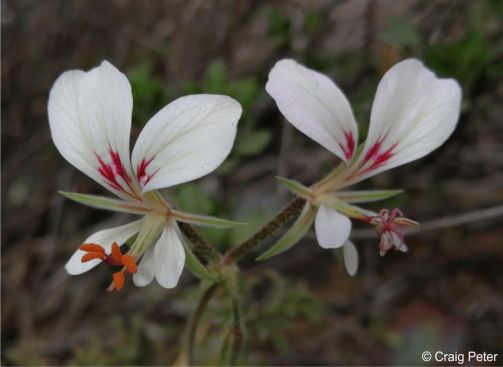
Description
Description
Pelargonium exhibens is a sparsely branched, climbing, evergreen subshrub, growing up to 300 mm in its natural habitat. Stems are herbaceous, smooth, turning brown with age and appear silky under a microscope. Leaves are semi-succulent, trilobed, bright green, hairy to the naked eye; however, they are sparsely silky under the microscope. Leaflets 40–60 × 45–55 mm. Leaf stalks can be up to 100 mm long, sparsely silky, deciduous with soft triangular stipules that die back with the stalks or slightly earlier.
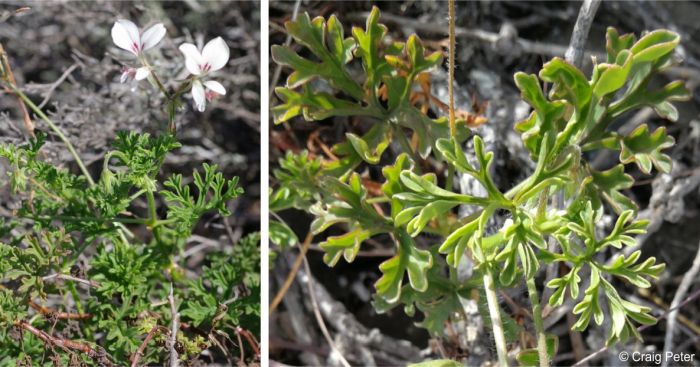
Pelargonium exhibens flowers from spring to autumn (September to May). The iInflorescence consists of 3–5 flowers with triangular bracts 3–5 × 1.5–2.0 mm growing from unbranched stalks, giving rise to 5 unequal petals, the upper two larger than the lower three, white to cream with deep red markings on the upper petals. The male reproductive parts (stamens) are completely exposed. Upon drying, the fruit splits open releasing 5 seeds, 6.0–7.5 mm long, with feathery tails up to 40 mm long.
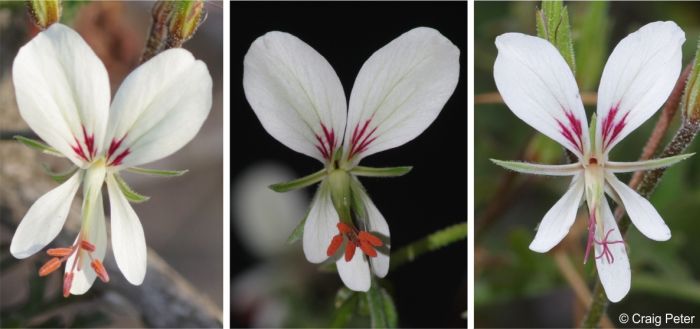
Pelargonium exhibens is morphologically similar to Pelargonium trifidum in terms of habit and leaf blade shape. P. exhibens can be easily separated by its exposed reproductive parts and broad leaves with narrowly tapered base. The leaves of Pelargonium exhibens are bright green and less fragrant compared to those of P. trifidum which are dull bluish green and release a strong scent when touched.
Conservation Status
Status
Pelargonium exhibens is assessed as Near Threatened (NT) in the SANBI Red list of South African plants, due to threats it faces in its natural habitat with the primary threats being medicinal use and overgrazing. Seeds have been collected by the Millennium Seed Bank Partnership (MSBP) South Africa and banked in the Millennium Seed Bank UK as a back-up and for future restorations. Living collections are to be curated at Kwelera National Botanical Garden in the Eastern Cape, South Africa.
Distribution and habitat
Distribution description
Pelargonium exhibens is a South African endemic confined to a few known locations in the Eastern Cape and parts of the Western Cape, where it grows in succulent mountain scrub and valley bushveld, experiencing sporadic rainfall, although most rainfall is experienced in the late summer months, between February and March. Exhibiting pelargonium would be well-suited for gardens that experience hot summers with sporadic rainfall throughout the year.
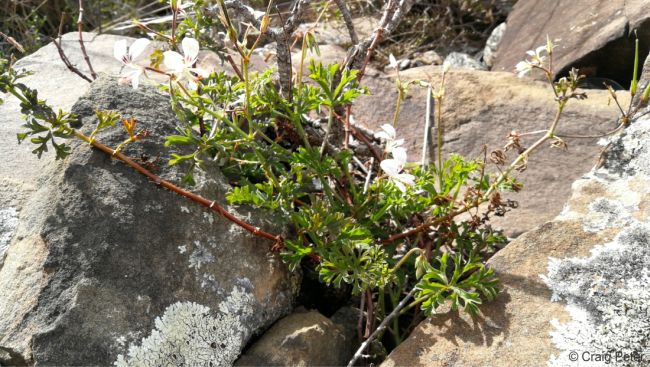
Derivation of name and historical aspects
History
The genus Pelargonium was named by Johannes Burman (1707–1780), a Dutch physician and botanist and is derived from the Greek word pelargos, meaning ‘stork’ because the fruit resembles the bill of a stork before it splits open to release the seeds. The specific epithet exhibens is Latin meaning ‘exhibiting’, in reference to the showy and attractive deep red-tinged white flowers.
The genus Pelargonium belongs to the Geraniaceae, a family consisting of 11 genera and 800 species, found in temperate localities around the world with the highest occurrence (81%) recorded in southern Africa. Noteworthy members of the Geraniaceae include Pelargonium and Geranium. Pelargonium is popular in the botany fraternity for its high commercial and ornamental value.
Pelargonium exhibens is a poorly documented species. Dr. Harry Bolus (1834–1911), a South African botanist and philanthropist, collected Pelargonium exhibens more than 120 years ago, yet the species was only found again 52 years later and to date only a few known localities have been recorded.
Ecology
Ecology
Pelargonium exhibens has bright orange pollen and attracts various pollinators such as bees, moths and birds foraging for pollen and nectar. The seeds have spirally arranged, feathered tails and are dispersed by wind. The spiral arrangement enables the seed to drill itself into the ground, increasing the chances of germination in the wild.
Pelargonium exhibens becomes dormant in winter and this enables it to survive the cold temperatures in its habitat.
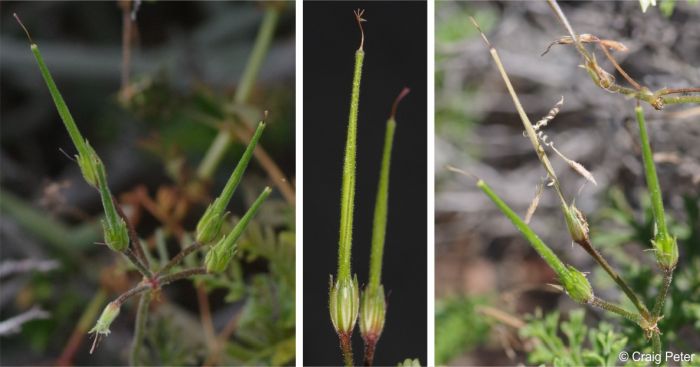
Uses
Use
Pelargonium exhibens is believed to be used medicinally as an antiseptic to treat sore throats and skin infections; however, the uses have not been documented yet. Extracts of some species of Pelargonium have been commercialised and are used to treat respiratory conditions, including common colds and flu, diarrhoea and colic. The possibility of this species being similarly used cannot be ruled out.
The white flowers with deep red markings suggest horticultural potential. Exhibiting pelargonium could make an attractive ornamental garden and container plant.
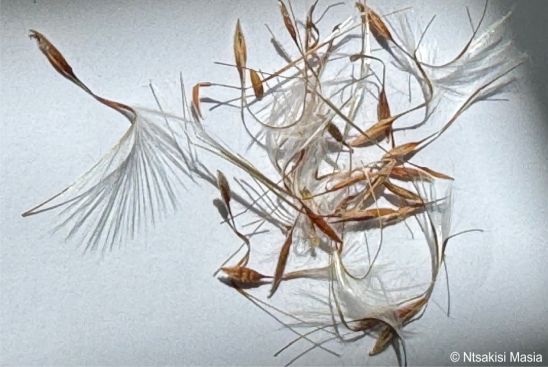
Growing Pelargonium exhibens
Grow
Pelargonium exhibens can be grown from seeds and cuttings; however, cuttings are most preferred as rooting is almost guaranteed at optimal conditions. Source cuttings from healthy plants, in the morning, during the active growth phase. Take 5–7 cm long cuttings, remove the leaves from the lower parts, cut below the leaf node and dip into rooting hormone suitable for softwood and semi-hardwood cuttings and plant into trays of well-drained sand and milled bark mixture. Place the cuttings in a semi-shaded area, ensuring the medium remains moist, not too wet and not too dry. Rooting can be expected in 2–4 weeks. Feed the rooted cuttings with phosphorous-rich liquid fertilizer to encourage root development. Transplant rooted cuttings individually into nursery bags or plant into well-drained garden beds.
Seeds should be collected upon maturity from disease-free plants. Sow seeds in a light, well-drained seedling mix. Water the trays with a fine hose, avoid overwatering as too much water may cause the seeds to rot. Expect germination between 4 and 6 weeks.
Grow Pelargonium exhibens in a lightly shaded rockery or well-drained (sandy) garden beds, experiencing sporadic rainfall, hot summers and dry, moderately frosty winters.
References
- Oliver, R. 2020. Pelargonium gibbosum (L.) L’Hér. (Geraniaceae). PlantZAfrica. Online. http://pza.sanbi.org/pelargonium-gibbosum.
- Peter, C. 2025. Observations of Pelargonium exhibens. iNaturalist. Online. https://www.inaturalist.org/observations?taxon_id=591584&user_id=craigpeter.
- Van Der Walt, J.J.A. & Vorster, P.J. 1988. Pelargoniums of southern Africa: including some representative species from other parts of the world. Vol. 3. National Botanic Gardens Kirstenbosch, Cape Town.
- Van der Walt, J J A. 1977. Pelargoniums of South Africa. Purnell, Cape Town.
- Victor, J.E. & Dold, A.P. 2009. Pelargonium exhibens Vorster. National Assessment: Red List of South African Plants. http://redlist.sanbi.org/species.php?species=1976-120.
- Vorster, P. 1986. Pelargonium exhibens (Geraniaceae): from the Eastern Cape Province: a new species. South African Journal of Botany 52(5):481– 484.
- Webb, W.J. 1984. The Pelargonium family: the species of Pelargonium, Monsonia and Sarcocaulon. Croom Helm, London.
Credits
Ntsakisi Masia
Kwelera National Botanical Garden
March 2025
Acknowledgements: the author thanks Craig Peter for providing images through iNaturalist, and Sibahle Gumede and Rob Ferb for sharing their knowledge of the species.
Plant Attributes:
Plant Type: Shrub
SA Distribution: Eastern Cape
Soil type: Sandy, Loam
Flowering season: Spring, Early Summer, Late Summer, Autumn
PH: Acid, Neutral
Flower colour: Red, White
Aspect: Full Sun, Morning Sun (Semi Shade), Afternoon Sun (Semi Shade)
Gardening skill: Average
Special Features:
Horticultural zones
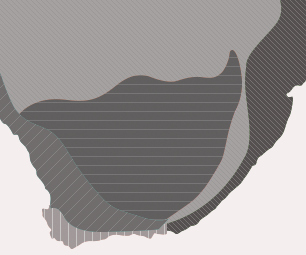








Rate this article
Article well written and informative
Rate this plant
Is this an interesting plant?
Login to add your Comment
Back to topNot registered yet? Click here to register.